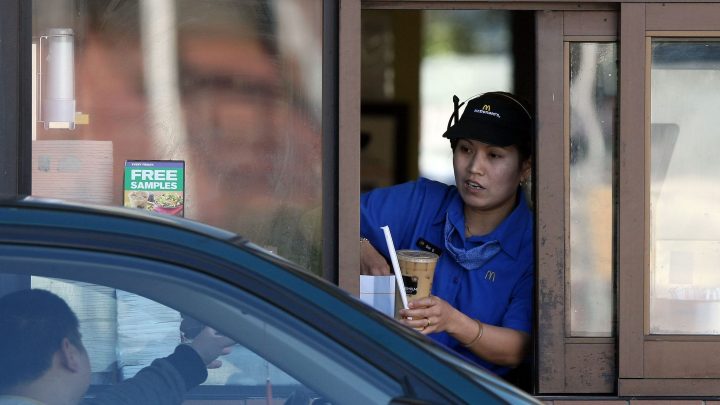
How expensive fast food can explain rising economic equality
How expensive fast food can explain rising economic equality

Over the last two years, Chick-fil-A’s prices have soared more than 20%. McDonald’s dollar menu is basically caput. And Subway’s $5 footlongs are a thing of the past. The days of cheap fast food feel like they’re over.
But while fast food prices are climbing, another thing is happening in society: Economic inequality is falling.
Between 2020 and 2022, workers at the bottom of America’s income distribution saw their real wages grow by more than 5%, while those at the top saw their real pay drop by 5% on average.
Eric Levitz, a senior correspondent with Vox, joined “Marketplace’s” Kai Ryssdal to explain why he thinks those two things may be related. An edited transcript of their conversation is below.
Kai Ryssdal: How did you come to write this piece?
Eric Levitz: I was surfing social media over the holidays, taking a break from actually spending quality time with my family, and I saw this argument bubbling up about a socialist commentator named Doug henwood. He tweeted, “I can’t imagine why people think this isn’t a great economy. Lunch for three at McDonald’s: $44!!” And that just led me to think about this really bigger question. Over the past three years, we’ve seen a historic reduction in income inequality, the largest we’ve seen since Ronald Reagan’s [1980] election. At the same time, we’ve seen really strong popular disapproval of the economy. And so the question of: Are there some tensions that get surfaced when inequality goes down? That was a question I was interested in.
Ryssdal: So connect the dots for me then on the premise of this thing, that $44 for a family of three at McDonald’s is actually about lower economic inequality.
Levitz: So it’s not exclusively about that for certain, but what we’ve seen since the pandemic is a really large increase in real wages for those in the bottom 10% of the income distribution who have seen their real wages, even when accounting for inflation, go up by 5.7% between 2020 and 2022. And then in the fast food sector, specifically, where a lot of those workers work, wages have gone up by about 30%. At the same time, wages have not been rising nearly as fast for those at the top of the income distribution, and inflation has, in fact, taken a bite out of their real wages so that their real pay actually dropped by about 5%. You put those two things together and what you see is that about 40% of the post-Reagan increase in inequality has been reversed just in these last few years.
Ryssdal: The upper-middle class having to pay more for McDonald’s, and the rich in this country having to pay more for McDonald’s, one cannot get too wrapped up about, No. 1, right? No. 2, the people on the lower end of the income spectrum have seen those wage gains, as you mentioned. What you didn’t talk about was that group and the middle. Is that where the burden falls then?
Levitz: Yeah, there are real burdens that come from rising labor costs. As you have a tight labor market, where there are lots of job opportunities for workers, where businesses are bidding against each other, you see heightened competition to get workers into those jobs. That leads to higher wages, which leads to higher prices, which, as you say, doesn’t just affect those at the top of the income distribution. There are lots of working-class and middle-class families that rely on fast food for some of their meals. And there is a real burden there.
Ryssdal: Right. Let me let me get back to that thing you mentioned about 40% of the Reagan-era income inequality basically disappearing during, and because of, what happened in the pandemic. Was it really as simple as pay people at the bottom more, and we just didn’t do that all along?
Levitz: Yeah, I think that the main thing, really, is that during the COVID-19 recession, the amount of stimulus that we put into the economy was greater than the hole in demand that the COVID recession created. And so we ended up in a situation where there’s really high demand for workers. And that translates to higher bargaining power for workers, which translates to rising wages in these sectors that had previously, for a long time, been able to get by paying really, really bad wages.
Ryssdal: Let me get us back to where we started: $44 for a family of three at McDonald’s. Can we have high working-class wages in this economy and still have cheap hamburgers, if I can drastically oversimplify?
Levitz: Yeah, I think so. While I’m focusing on the role of labor costs, fast food prices are determined by a lot more than just that. You have the other variable of consumer demand. These businesses are not going to charge only what they need to cover their costs and then a tiny bit of profit, they’re going to try to charge as much as they can without losing customers. And that number goes up when there’s high consumer demand. And I think that if we hadn’t seen sort of the unrelated increases in commodity prices on international markets for food, price increases for fast food would have been significantly less.
There’s a lot happening in the world. Through it all, Marketplace is here for you.
You rely on Marketplace to break down the world’s events and tell you how it affects you in a fact-based, approachable way. We rely on your financial support to keep making that possible.
Your donation today powers the independent journalism that you rely on. For just $5/month, you can help sustain Marketplace so we can keep reporting on the things that matter to you.

















